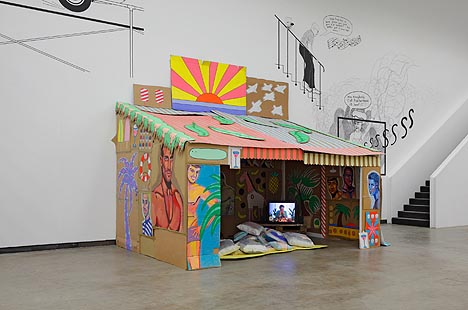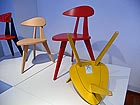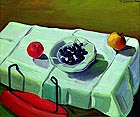
translated and summarized by: Liz Wollner-Grandville,
English summary March 1 - 7
Kunsthalle Wien
Lives and works in Vienna III
05.03.10 – 30.05.10
32 out of 600
Compared to the last exhibition series “Lives and Works in Vienna”, which is held every five years, the current one, curated by Xenia Kalpaktsoglou, Raphaela Platow, Angela Stief, Olga Sviblova, is rather chaotic. Last time, a scaffold by the architects propeller z structured the space, this time only the art works structure the exhibition design.
In 2005, the majority of the artists were well known (Carola Dertnig, Dorit Margreiter, Muntean/Rosenblum, Constanze Ruhm), this time they are all new discoveries, who until now have never been presented by established Viennese institutions or galleries. Among them are Maria Bussmann with her threatening surrealistic drawings or Stephen Mathewson with his tragic-funny comic strip.
Additional sympathy is gained by inviting artists who not only offer diverse positions but also represent various generations. Rudolf Polanzky, Mara Mattuschka and Hubert Sielecki represent the generation of the over 50-year olds, and others, like Kathi Hofer or Marianne Vlaschits, were born in the 1980’s.
Every attempt to “measure” the scene is difficult, and it is not easy to find new paths in this relatively small metropolis compared to other European cities – only 32 out of 600 submissions were accepted. Some examples of the works presented here include grotesque pieces (e.g. Tillmann Kaiser’s “Harmolodisches Gebirge”, Constantin Luser’s grandiose fineliner-drawings, Rudolf Polanzky’s bizarre performance videos), constructive-analytical work (e.g. Manuel Knapp’s stage-like installations, Luisa Kasalicy’s building material setting), and expressive work (e.g. Tomak’s brutal paintings, Mara Mattuschka’s crazy film). On the other hand, the “Theory-Politics-Social Criticism”-Party is only represented in a homeopathic dose – and if this is justified, remains questionable. How the Vienna artist’s scene will be valued elsewhere, remains to be seen in July at the Secession.
By Nina Schedlmayer
Kunsthalle Wien
1070 Vienna, Museumsplatz 1
Tel: +43 (0)1 521 89 – 0
Fax: +43 (0)1 521 89 – 0
www.kunsthallewien.at
Opening hours: daily from 10 a.m. to 7 p.m.
Museum für Angewandte Kunst Köln
Mondays at Papst’s
19.01.10 until 21.03.10
Rose Monday at Papst’s
It cannot be confirmed if he performed at the Carnival in Cologne. But each Rose Monday, since the end of the 1950's, a small group of creative and unconventional thinkers regularly met with Walter Papst. The pink ladder that led from Papst’s apartment and “Studio for Industrial Design and Product Development” to his party cellar is among the objects on display at the exhibition of the Museum for Applied Arts in Cologne. Another object is the large drum (“de decke Trumm”), on which Papst played at the Rose Monday parade. Walter Papst’s active period lasted until the mid 70’s. The humongous book-project, “Der Götterbau”, filled the rest of his life to 2008.
His work as a designer took place during the 50’s and the 60’s - stylistically between the Scandinavian furniture trends of Vernon Panton and Purism. Papst’s work-spectrum commenced with an ingenious ergonomic tripod-stool construction, which he developed out of a milking stool. And there is a bathtub-like park bench made of glass-reinforced plastic, an object that even withstood a brown bear attack at the Zoo in Ulm in 1961. In contrast, Papst’s beach chair-alternative, a kind of synthetic fiber-shell, disappeared after the first stiff breeze at the Kiel firth. Papst engraved will always be remembered for his three-legged stool, which, long before the ergonomic sitting-ball alternative, was used with the backrest positioned in front. In 1955, his tripod was even recommended by for use as school furniture. In 1972, Papst developed a chair named “Munken” for IKEA, shortly before the DIY-Swedes marked the global furnishing world in blue-and-yellow.
By Roland Groß
Museum für Angewandte Kunst Köln
50667 Köln, An der Rechtschule
Tel: 0221 – 221 – 26735
Fax: 0221 – 221 – 238 85
www.museenkoeln.de/museum-fuer-angewandte-kunst
Opening hours: Tue-Sun 11 a.m. – 5 p.m.
Westlicht. Schauplatz für Fotografie
Herbert List Retrospective
09.02.10 – 05.04.10
Bucolic melancholic
Herbert List, born 1903 as the son of a Hamburg-based family renowned as coffee importers, was introduced to photography by the Bauhaus-member Andreas Feininger. During the 1930’s, List devoted his work to the photographic style of “new vision” by utilizing shadows, mirror-effects, masks, and disguise. The first part of the exhibition deals with the surrealism of his “fotografica metafisica”. List lived in Paris during the 30’s where he met Jean Cocteau, and was strongly influenced by de Chirico and Eugène Atget. He created double exposed works, occasionally also photomontages showing surreal arrangements dealing with violence and destruction, composed under the impact of the Nazi-horrors, and carried forward in elegiac photos of the bombed city of Munich.
In general, List’s Leitmotiv centred on melancholy, on the bucolic Greek black-and-white still life, young men casting their eyes up into the morning light, melancholic beach-beauties in bathing shorts, which, despite their innocent aesthetics, List hid in a “poison suitcase” under his bed. And the people living in the slums of Naples, which he photographed and later published in a book together with Vittorio de Sica (1962) - without any hint of social voyeurism, neither glorifying nor lachrymosely.
In the 1950’s he created numerous portraits of intellectuals, composers, artists and actors, which, in the case of quirky personalities such as Marino Marini and Giorgio Morandi, turned out to be rather bizarre. Without any doubt Herbert List has earned his place on the Olymp of classic photography. And his Olymp definitely has a sandy beach.
By Iris Meder
Westlicht. Schauplatz für Fotografie
1070 Vienna, Westbahnstrasse 40
Tel: +43 (0) 1 522 66 36 – 0
Fax: +43 (0) 1 523 13 08
www.westlicht.com
Bank Austria Kunstforum
A feast for the eyes – Food in still life
10.02.10 – 30.05.10
Top-notch
Admittedly: the exhibition “A feast for the eyes – food in still life” is debatable. Is it really necessary to accompany the exhibition with a gourmet dish and publish recipes in the catalogue, such as Johanna Maier’s “Green Apple Sorbet served with Champagne Soup” which, of all things, is positioned next to a rather nightmarish still life by Maria Lassnig?
Curator Heike Eipeldauer collected still lifes - ranging from their beginnings to contemporary examples: one embarks with the “Birth of a still life”, among others with the “Holy Family” by Joos van Cleve (1515): an arrangement showing a citrus fruit, a knife and a cup, which only serves as a requisite for the scene. In Pieter Arten’s “Christ at Maria and Martha’s” a large piece of meat takes the foreground, while the scene recedes.
In other examples, the still life is perceived as an artistic field for experimenting: highlights being works by Willem Klaf or Rudolf Wacker. Martha Rosler’s “Kitchen Semiotics” are positioned in connection with the genre “a female coded room”, similar to the paintings by Paula Modersohn-Becker or Berthe Morisot. Christian Ludwig Attersee’s once existing humour becomes apparent in the meat-department: in his pop-art painting beautifully manicured fingers are draped with ham and arranged as tasty canapés.
Maybe the exhibition could have been more compact and smaller. But all in all, the project offers a good overview of this popular genre and at the same time offers new approaches. Additionally, the project distinguishes itself by combining Old Masters and contemporary art without being zealous. What would we do without the Kunstforum?
By Nina Schedlmayer
Bank Austria Kunstforum
1010 Vienna, Freyung 8
Tel: 01 711 91 57 42
www.kunstforumwien.at
Opening hours: Tue – Sun 10.00 a.m. – 7 p.m.
Mehr Texte von translated and summarized by: Liz Wollner-Grandville


 Teilen
Teilen





